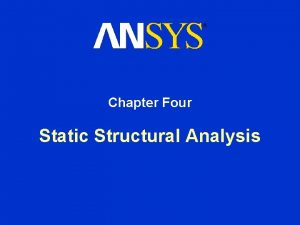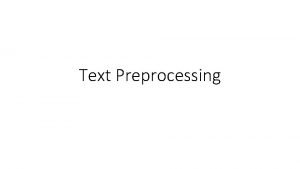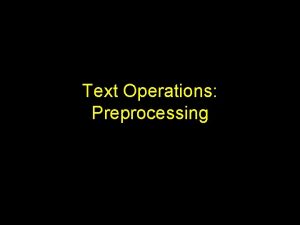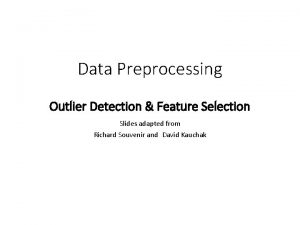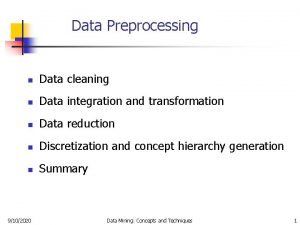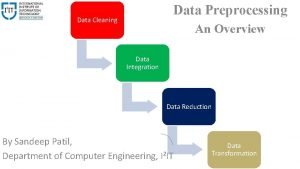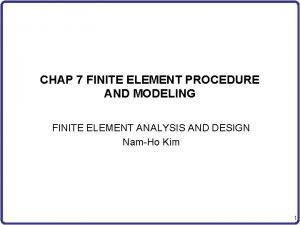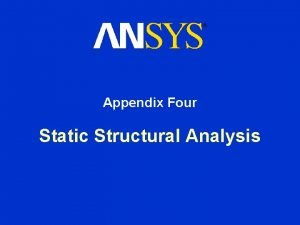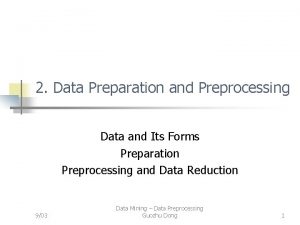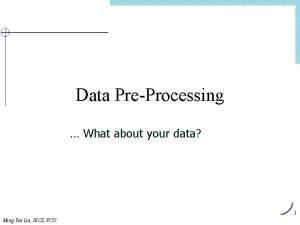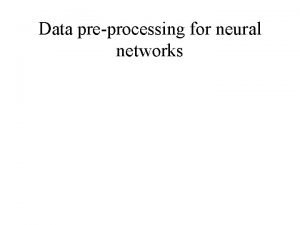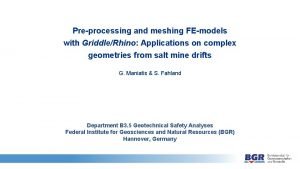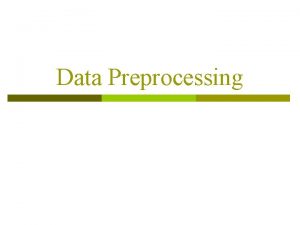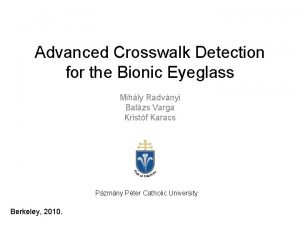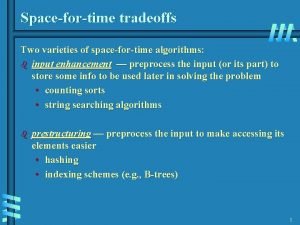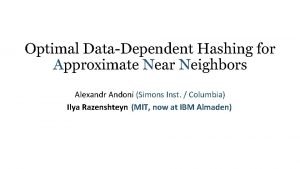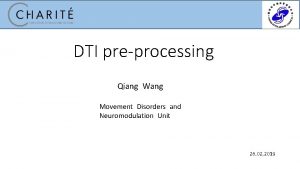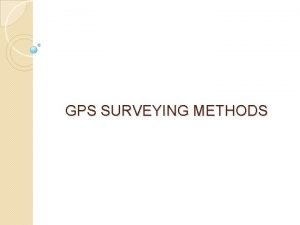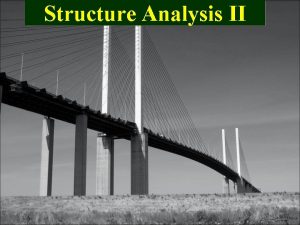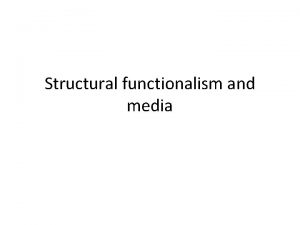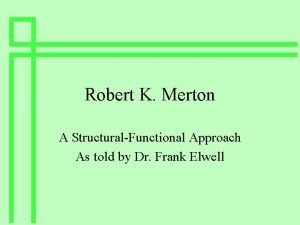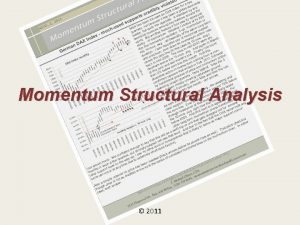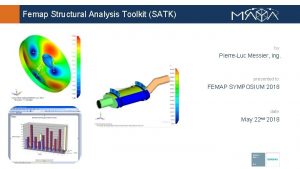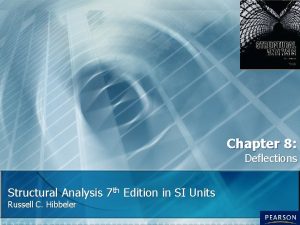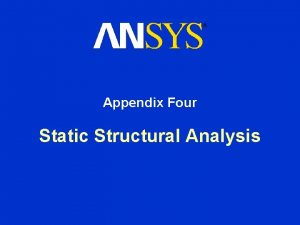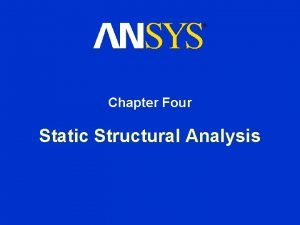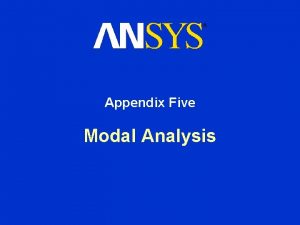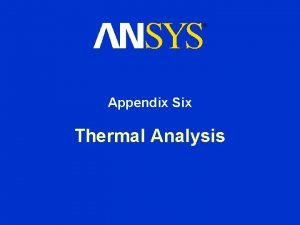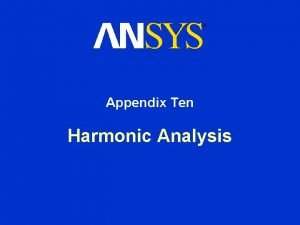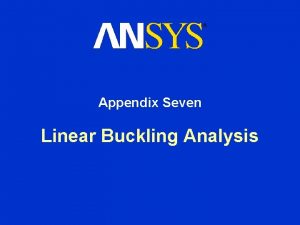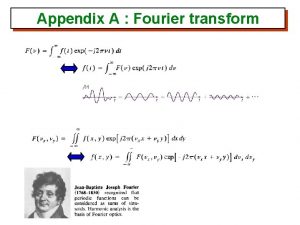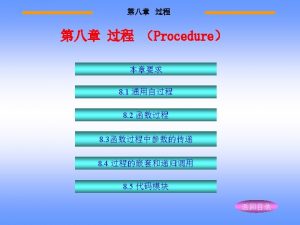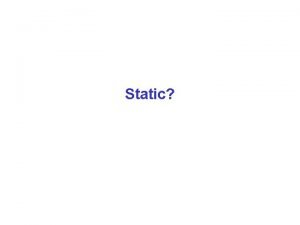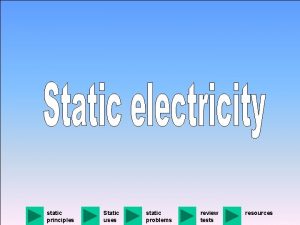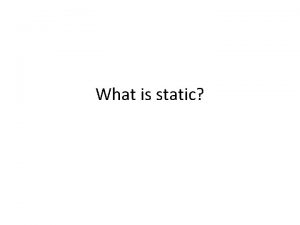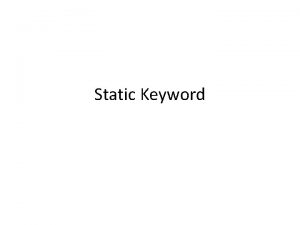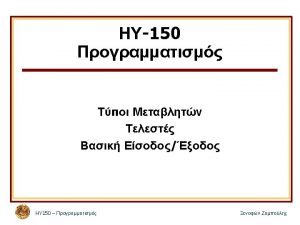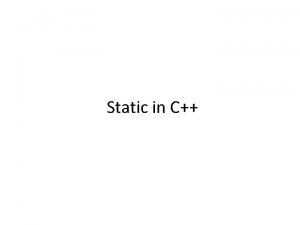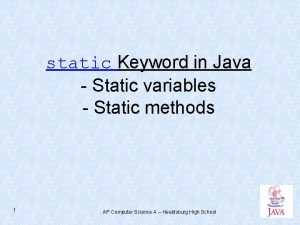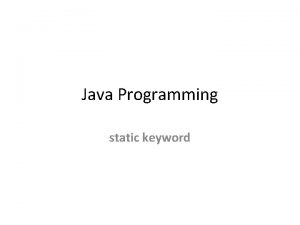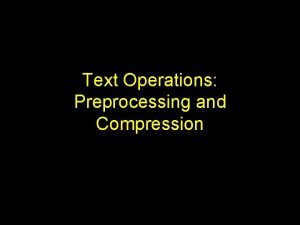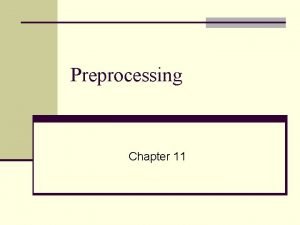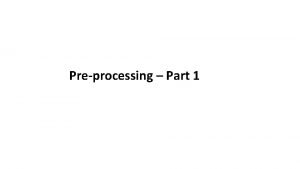Appendix Four Static Structural Analysis General Preprocessing Procedure
























- Slides: 24

Appendix Four Static Structural Analysis

General Preprocessing Procedure Basics of Linear Static Analysis Training Manual – Displacements, reaction forces, stresses, and strains are usually items of interest that the user wants to review • The general equation of motion is as follows: where [M] is the mass matrix, [C] is the damping matrix, [K] is the stiffness matrix, {x} is displacements, and {F} is force • Because this is a static analysis, all time-dependent terms are removed, leaving the following subset: ANSYS Workbench – Simulation • A linear static structural analysis is performed to obtain the response of a structure under applied static loads March 29, 2005 Inventory #002215 A 4 -2

General Preprocessing Procedure … Elements Used Training Manual – Solid bodies are meshed with 10 -node tetrahedral or 20 -node hexahedral elements • SOLID 187 and SOLID 186 – Surface bodies are meshed with 4 -node quad shell elements • SHELL 181 using real constants • Section definition (and offsets) are not used – Line bodies are meshed with 2 -node beam elements • BEAM 188 (with 3 rd orientation node) • Section definition and offsets are supported ANSYS Workbench – Simulation • In Simulation, the following elements are used: March 29, 2005 Inventory #002215 A 4 -3

General Preprocessing Procedure … Point Mass (ANSYS Details) Training Manual – A translational-only MASS 21 (KEYOPT(3)=2) has given mass – RBE 3 -type of surface constraint is enabled with CONTA 174, which are generated on associated ‘surfaces’ • KEYOPT(2)=2 for MPC algorithm • KEYOPT(4)=1 for nodal detection (contact) • KEYOPT(12)=5 for bonded contact – A pilot node TARGE 170 is generated at the same node as the MASS 21. • KEYOPT(2)=1 for user-supplied constraints • KEYOPT(4)=111111 for all DOF active ANSYS Workbench – Simulation • Internally, the Point Mass is modeled as a concentrated mass connected to surfaces with RBE 3 constraints – Note that RBE 3 has 6 DOF but MASS 21 only has 3 DOF and no rotary inertia. Also, since RBE 3 -type of surface constraint used (rather than CERIG-type of surface constraint), there is no stiffness between point mass and rest of structure. March 29, 2005 Inventory #002215 A 4 -4

General Preprocessing Procedure … Assemblies – Solid Body Contact Training Manual – By default, pure penalty method is used with relative contact stiffness of 10 with symmetric contact pairs being generated – For bonded and no separation contact, any geometric penetration or gap is ignored if within the pinball region. – For frictionless and rough contact, considering “actual geometry” makes any initial gap or penetration ramped whereas “adjust to touch” closes gap with auto CNOF ANSYS Workbench – Simulation • Internally, the solid face contact regions are modeled in ANSYS as CONTA 174 and TARGE 170 elements – NEQIT is set to 1 for if only bonded or no separation contact exist; it is set higher otherwise (20 -40, depending on model). March 29, 2005 Inventory #002215 A 4 -5

General Preprocessing Procedure … Assemblies – Surface Body Contact Training Manual – Contact involving solid edges default to pure penalty method – Contact involving surface edges use MPC formulation. Instead of “target normal, ” if search direction is “pinball region, ” KEYOPT(5)=4 set on companion TARGE 170 element. – For bonded contact (default), both use KEYOPT(12)=5 and KEYOPT(9)=1. • For surfaces in contact with other faces, standard surface-to-surface contact is used, namely CONTA 174 and TARGE 170 Example of Simulationgenerated edge-to-edge contact, which results in CONTA 175 on one edge and TARGE 170 on the other. ANSYS Workbench – Simulation • Internally, any contact including an edge (solid body edge or surface edge) results in asymmetric contact with CONTA 175 for the edge and TARGE 170 for the edge/face March 29, 2005 Inventory #002215 A 4 -6

General Preprocessing Procedure … Assemblies – Spot Weld Training Manual – The BEAM 188 elements use same material properties as underlying materials but with an appropriate circular cross-section with radius= 5*thickness of underlying shells – Figure on right shows spotwelds between two sets of shell elements, which are made translucent for clarity. ANSYS Workbench – Simulation • Internally, spot welds are defined as a set of BEAM 188 elements. The spot weld is defined with one beam element, and the top and bottom of the spot weld is connected to the shell or solid elements with a ‘spider web’ of multiple beams. March 29, 2005 Inventory #002215 A 4 -7

General Preprocessing Procedure … Inertial Loads in ANSYS Training Manual – Acceleration and Standard Earth Gravity are represented via ACEL command – Rotational velocity is defined via CGLOC (defines origin) and CGOMGA (defines rotational velocity about CGLOC) ANSYS Workbench – Simulation • Inertial loads are modeled in ANSYS as follows: March 29, 2005 Inventory #002215 A 4 -8

General Preprocessing Procedure … Structural Loads in ANSYS Training Manual – Pressures are applied directly on surfaces via SF, , PRES – Forces on vertices and edges are applied as nodal loads via F, , FX/FY/FZ – Forces on surfaces are applied as pressures on face 5 of surface effect elements SURF 154 with KEYOPT(11)=2 • KEYOPT(11)=2 to use full area, including tangential component – Bearing loads are applied as pressures on face 5 of surface effect elements SURF 154. Two sets are created for axial and radial components of bearing load: • Axial component uses KEYOPT(11)=2 for pressure on full area • Radial component uses KEYOPT(11)=0 for pressure (which is applied on compressive part of cylinder only) on projected area w/ tangential component ANSYS Workbench – Simulation • Structural loads are modeled in ANSYS as follows: – Moments on vertices or edges of shells are applied as nodal loads via F, , MX/MY/MZ March 29, 2005 Inventory #002215 A 4 -9

General Preprocessing Procedure … Structural Loads in ANSYS Training Manual – Surface constraint is RBE 3 -type of distributed loading – Pilot node at surface CG defined by TARGE 170 with KEYOPT(2)=1 and KEYOPT(4)=xxx 000 – Surface is defined by CONTA 174 with KEYOPT(2)=2, KEYOPT(4)=1, KEYOPT(12)=5 – Moment applied as nodal load on pilot node • Remote force load is defined by surface constraint – Surface constraint is RBE 3 -type of distributed force – Pilot node at force origin defined by TARGE 170 with KEYOPT(2)=1 and KEYOPT(4)=000 xxx – Surface is defined by CONTA 174 or CONTA 175 with KEYOPT(2)=2, KEYOPT(4)=1, KEYOPT(12)=5 ANSYS Workbench – Simulation • Moment load on surface is defined by surface constraint – Force applied as nodal load on pilot node March 29, 2005 Inventory #002215 A 4 -10

General Preprocessing Procedure … Structural Supports in ANSYS Training Manual – Fixed support constraints result in D, , ALL for given entity – Given displacement is D, , UX/UY/UZ for specified direction (if CS is supplied, nodes are rotated in that local CS) – Frictionless surface involves nodal rotation such that UX is in normal direction, and D, , UX is applied – Cylindrical constraint rotates nodal coordinates in cylindrical CS and constrains appropriate direction with D, , UX/UY/UZ – Simply supported constraints apply D on UX, UY, and UZ on shells or beams – Fixed rotation constraints apply D on ROTX, ROTY, and ROTZ on shells or beams ANSYS Workbench – Simulation • The following are applied internally in ANSYS: – For compression-only supports, the surface mesh is copied to form a rigid target surface (TARGE 170) on top of the original surface (CONTA 174). Standard contact behavior is used to model this support, and that is why it is a nonlinear solution. March 29, 2005 Inventory #002215 A 4 -11

General Preprocessing Procedure … Thermal Loading in ANSYS Training Manual – ANSYS will always solve a thermal solution first • Even if a uniform temperature field is applied, a thermal solution will be performed. This is why temperature body loads in a structural analysis is not possible with an ANSYS Structural license. – Reference temperature is defined with TREF (not MP, REFT) • TREF and TUNIF commands are set to the same value, as specified under “Reference Temp” of the Environment branch Details view – Coefficient of thermal expansion per material is supplied with MP, ALPX (not MP, CTEX or MP, THSX) – Temperature loading is input via BF commands after thermal solution ANSYS Workbench – Simulation • In ANSYS, for any thermal loads present in the model: March 29, 2005 Inventory #002215 A 4 -12

General Preprocessing Procedure … Solution Options in ANSYS Training Manual – The solvers used are either the direct sparse solver (EQSLV, SPARSE) or the PCG solver (EQSLV, PCG) – A simplified discussion between the two solvers: • If given the linear static case of [K]{x} = {F}, Direct solvers factorize [K] to solve for [K]-1. Then, {x} = [K]-1{F}. – This factorization is computationally expensive but is done once. • Iterative solvers use a preconditioner [Q] to solve the equation [Q][K]{x} = [Q]{F}. Assume that [Q] = [K]-1. In this trivial case, [I]{x} = [K]-1{F}. However, the preconditioner is not usually [K]-1. The closer [Q] is to [K] -1, the better the preconditioning is, and this process is repeated - hence the name, iterative solver. – For iterative solvers, matrix multiplication (not factorization) is performed. This is much faster than matrix inversion if done entirely in RAM, so, as long as the number of iterations is not very high (which happens for well-conditioned matrices), iterative solvers can be more efficient than sparse solvers. ANSYS Workbench – Simulation • The solver selection for direct vs. iterative: – The main difference between the iterative solvers in ANSYS — PCG, JCG, ICCG — is the type of pre-conditioner used. March 29, 2005 Inventory #002215 A 4 -13

General Preprocessing Procedure … Solution Options in ANSYS Training Manual – If used, weak springs are added to the mesh. These are modeled with COMBIN 14 with small stiffness and added to the extreme dimensions of the part. • Solver working directory: – The ANSYS input file is written as “ds. dat” in the solver directory. The output file is “solve. out” and can be viewed in the “Solution Information” branch of the “Solution” branch. – ANSYS is executed in batch mode (-b) as a separate process. During solution, the results file. rst is written. The results are also read in and XML results files are generated in batch mode. The XML files are then read into Simulation. – All associated ANSYS files have default jobname of “file” and are deleted after solution, unless changed in “Tools > Options … > Simulation: Solution > Save Ansys Files”. ANSYS Workbench – Simulation • Weak spring option: March 29, 2005 Inventory #002215 A 4 -14

General Preprocessing Procedure … Solution Options in ANSYS Training Manual – Solution control (SOLCON, OFF) is turned off – Multiframe restart is turned off (RESCON, , NONE) – ANSYS shape checking is turned off (SHPP, OFF) – Number of equilibrium iterations (NEQIT) is set to 1 if contact is not present or if all contact is bonded or no separation. • Otherwise, it is automatically determined, such as NEQIT, 20 (frictionless contact) or NEQIT, 40 (rough contact). NSUBST, 1, 10, 1 is also set in these cases. – Only requested results is output with OUTRES, not everything by default • Results are later written to XML files in /POST 1, which are then read back into Simulation. Hence, Simulation does not directly read the results from the. rst file ANSYS Workbench – Simulation • Various defaults in ANSYS are turned off when solving in Simulation: March 29, 2005 Inventory #002215 A 4 -15

General Preprocessing Procedure … Stresses and Strains – Because stress is a tensor, it is hard to evaluate the response of the system by looking solely at stress components – The “Stress Tool” allows the user to have Simulation calculate scalar results related to factors of safety – In the next slides, stress results will be discussed, along with different criteria of evaluating material response, as available from the Stress Tool. – The “Stress Tool” branch controls what theory will be used and what type of stress limit will be used. ANSYS Workbench – Simulation • Safety Factors can be used to evaluate designs: Training Manual March 29, 2005 Inventory #002215 A 4 -16

General Preprocessing Procedure … Principal Stresses Training Manual – From basic mechanics review, the stress tensor can be rotated such that only normal stresses appear. These are three principal stresses s 1 < s 2 < s 3. – Principal values of stress and strain results can be requested. The three principal values also have direction associated with them, and a “Vector Principal” output can be selected. • Principal values can be exported to Excel with Euler angles – In the example shown on the right, one can easily see three principal stresses (white=max, blue=min). From this, one can see that the part is undergoing bending with one side in tension and the other in compression. ANSYS Workbench – Simulation • Principal Stresses and Strains: March 29, 2005 Inventory #002215 A 4 -17

General Preprocessing Procedure … Principal Stresses Training Manual ANSYS Workbench – Simulation • Maximum Tensile Stress Theory: – The maximum tensile stress theory can be used for the “Stress Tool”. It utilizes the maximum principal stress and is generally suitable for brittle materials. – The criterion can be thought of as the following: where st is the ultimate (or yield) tensile strength – If plotted in two-dimensional principal stress space, the failure surface results in a square as shown below. A stress state lying inside the square is assumed to be fine but any stress state lying on the edges of the square will fail. s 2 – The max tensile stress criterion, as its name implies, only considers the tensile behavior. For many brittle materials, the compressive strength is much greater, so this assumption may be valid. st st s 1 March 29, 2005 Inventory #002215 A 4 -18

General Preprocessing Procedure … Principal Stresses Training Manual ANSYS Workbench – Simulation • Mohr-Coulomb Theory: – The Mohr-Coulomb theory can be used for the “Stress Tool”. It utilizes the maximum and minimum principal stresses and is suitable for brittle materials. – The criterion is as follows: where st and sc are the ultimate (or yield) tensile and compressive strengths. – The failure surface is plotted in two-dimensional principal stress space below. Unlike the maximum tensile stress theory, the Mohr-Coulomb theory considers the s 2 effects of the compressive strength. st -sc s 1 March 29, 2005 Inventory #002215 A 4 -19

General Preprocessing Procedure … Equivalent Stress Training Manual – The von Mises or equivalent stress se is defined as: – This criterion is commonly used for ductile metals. – When uniaxial tensile tests of specimens are performed to determine the yield strength and stress-strain relationships, the engineer needs a way to relate the uniaxial data to the stress state (tensor). Hence, the equivalent stress is a commonly used scalar invariant for this purpose. ANSYS Workbench – Simulation • Equivalent Stress: March 29, 2005 Inventory #002215 A 4 -20

General Preprocessing Procedure … Equivalent Stress Training Manual ANSYS Workbench – Simulation • Maximum Equivalent Stress Theory: – The Maximum Equivalent Stress Theory can be used for the “Stress Tool”. It compares the equivalent stress with the yield (or ultimate) strength and is suitable for ductile materials. – The criterion is as follows: where sy is the tensile yield (or ultimate) strength. – The failure surface is plotted in two-dimensional principal stress space below. – A stress state can be separated into hydrostatic and s 2 distortional terms. The hydrostatic term contributes to volume change but the distortional term is associated with sy yielding. Hence, the maximum equivalent -sy stress criterion is also known as the distortion energy criterion. sy s 1 -sy March 29, 2005 Inventory #002215 A 4 -21

General Preprocessing Procedure … Maximum Shear Stress Training Manual – The maximum shear stress tmax is defined as which results in the largest principal shear stress – This value can be compared to the yield strength to predict yielding for ductile materials • Stress Intensity: – The stress intensity is twice the value of the maximum shear stress. – The stress intensity provides the value of the largest difference between principal stresses ANSYS Workbench – Simulation • Maximum Shear Stress: March 29, 2005 Inventory #002215 A 4 -22

General Preprocessing Procedure … Maximum Shear Stress Training Manual ANSYS Workbench – Simulation • Maximum Shear Stress Theory: – The Maximum Shear Stress Theory or the Tresca criterion can be used for the “Stress Tool”. It is suitable for ductile materials. – The criterion is as follows: where sy is the tensile yield (or ultimate) strength and f is a factor (default=0. 5) – The failure surface is plotted in two-dimensional principal stress space below with the von Mises criterion superimposed on in with a thin line. The two criteria are s 2 quite similar, although the Tresca criterion is slightly more conservative (maximum sy difference between the two does not exceed 15%). -sy sy s 1 -sy March 29, 2005 Inventory #002215 A 4 -23

General Preprocessing Procedure … Results (ANSYS Details) Training Manual – All contour result plots in Simulation are the same as nodal (averaged) solution with Full Graphics • Viewing Simulation contour plots would be similar to using PLNSOL with /GRAPH, FULL commands in ANSYS • No plotting is actually done in input file – this is to give an idea of equivalent plotting commands in ANSYS – Reaction forces for supports as well as nodal result data is sent to Simulation via XML files • XMLOPT and /XML commands are used – Contact (reaction) force calculations are performed by selecting contact surfaces and performing FSUM about centroid. This is repeated for target surfaces. ANSYS Workbench – Simulation • Postprocessing calculations are performed in /POST 1 after the solution as part of the ANSYS input file March 29, 2005 Inventory #002215 A 4 -24
 Static analysis in ansys
Static analysis in ansys Text preprocessing steps
Text preprocessing steps Text operations
Text operations Outlier
Outlier Etl in data cleaning and preprocessing stands for
Etl in data cleaning and preprocessing stands for Entity identification problem in data integration
Entity identification problem in data integration Image preprocessing
Image preprocessing Image preprocessing
Image preprocessing Sequential feature selection
Sequential feature selection Data pretreatment
Data pretreatment Neural network data preprocessing
Neural network data preprocessing Preprocessing fem
Preprocessing fem Major tasks in data preprocessing
Major tasks in data preprocessing Preprocessing in image processing
Preprocessing in image processing Password hashing and preprocessing
Password hashing and preprocessing Password hashing and preprocessing
Password hashing and preprocessing Dti preprocessing
Dti preprocessing Static survey procedure
Static survey procedure Cuckoo sandbox fork
Cuckoo sandbox fork Determine the vertical displacement of joint c
Determine the vertical displacement of joint c Structural functionalism definition
Structural functionalism definition Merton
Merton Michael oliver momentum structural analysis
Michael oliver momentum structural analysis Structural analysis toolkit for nastran
Structural analysis toolkit for nastran Structural analysis chapter 8 solutions
Structural analysis chapter 8 solutions
